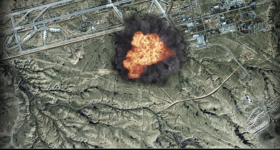
One of the dangers of inward military and ‘defense’ subcultures is that it can easily become polluted with political thinking, whereby its members become marinated in their own state and institutional propaganda. In the case of NATO member states, this means that for last decade at least, it’s become an institutional imperative to view everything as a potential threat from the ‘enemy’. Presently, the enemy de jour is Russia. We all remember the Cold War years when the ultimate ‘threat’ was always a nuclear first strike. It’s what people, politicians were trained to fear most. Later, during the War on Terror years (2001-2010), the ‘threat’ became an unpredictable one – posed by shadowy international terrorist brands like Al-Qaeda and ISIS, whose attack vestors were meant to be completely unconventional and asymmetrical in nature. Later, after terrorism died down, it was replaced with a new the ‘Russian threat.’ This prompted the US and its NATO client states to then move to shore-up their conventional military assets and respective budgets, before expanding what was previously a fledgling enterprise in comparison, known as ‘hybrid warfare’ which, according to defense mavens, could be literally anything; cyber, ‘influence’, election meddling, Russian news channels supposedly ‘sowing chaos and distrust’ among their own NATO zone domestic populations, or even constructing their own fifth columns (both at home or away). Just how many of these suspicions and fetishes are warranted is another matter. What was most imperative was securing funding for these and every other DoD program.

Pentagon 2020: A more esoteric version of World of Warcraft.
Money makes the world go round, and the US military industrial complex is no different. Its survival is all about securing funding to sustain itself, but to secure those budgets they need to market them to politicians and bureaucrats. In the world of ‘defense’, that marketing pitch normally takes the form of a “new military strategy” or “doctrine,” which more often than not, is much the same as the old one, only with a few new toys and software updates. Now that the War on Terror has been largely tapered down, and Russia has not materialized to be the real threat which western propaganda operations have been insisting it was for the last 5 years, US military scions are now hoping to repackage conventional military, nuclear and ‘hybrid’ warfare – into one big, all-singing and dancing strategy for the 21st century. If Pentagon brass can excite members of Congress with their new ideas, then they will be able to secure an increase in their overall 2020 ‘defense’ budget, hoping to push it well over $1 trillion next year.
In terms of Eurasia, Washington’s strategy will continue unabated in instigating more local conflicts around Russia’s borders – and if possible, influence and disrupt the internal Russian political situation. If they can sustain consistent instability, then they will not only secure present funding levels, but possibly increase them, too. Moreover, Pentagon brass who are successful with their funding applications are also securing their future positions on the board of any major defense contractor corporation in this ever-lucrative supply chain.
Here’s the latest creative marketing pitch to the American taxpayer…

South Front reports….
On March 14, US Defense Secretary Patrick Shanahan and Gen. Joseph Dunford, the Joint Chiefs of Staff chair, testified before the Senate Armed Services Committee on President Donald Trump’s 2020 defense budget request.
The chairman of the Joint Chiefs of Staff came out with several important remarks regarding the current US military doctrine and its expected actions in the event of conflict with some “adversary”.
Dunford warned against changing the current US military policy which allows the country to be the first to use nuclear weapons during a possible conflict. The general emphasized that he “absolutely” believes that “the current policy is the right policy”.
“I wouldn’t make any decisions to simplify an adversary’s decision-making calculus. I can also imagine a few situations where we wouldn’t want to remove that option from the president”, he stressed.
Dunford added that cyber weapons will unlikely replace nuclear forces, but stressed that the US should be ready to carry out offensive cyber operations. Describing the need for cyber operations, he mentioned China and Russia as well as cyber attacks allegedly conducted by these two states as the reason behind this need.
These remarks come in relations to the newly appearing US military doctrine, which actively employs nuclear threats, cyber attacks and ‘fifth columns’ in order to contain and defeat supposed US ‘adversaries’. This doctrine was in details described by the Chief of the General Staff of the Armed Forces of Russia General Valeriy Gerasimov earlier in March.
Pentagon started to develop a qualitatively new strategy of military operations which has already been dubbed the “Trojan horse”.
It amounts to active use of the “protest potential of a potential fifth column” in the interests of destabilizing situation while simultaneously precision-guided munition (PGM) strikes are launched at key targets,” General Gerasimov sated describing a part of it.
Most likely, this new US doctrine is currently being employed in Venezuela. However, in the event of conflict with Russia the success of this strategy of aggression will hardly be possible without the employment of nuclear forces, at least precision tactical nuclear strikes.
This is the real reason of Dunford’s remarks in favor of the first-strike nuclear policy. The rest is mostly a formal justification for such an approach. Speculations that Russia may employ tactical nuclear weapons in some conflict in order to achieve a victory before the intervention of US or NATO forces are ridiculous. There are two main reasons:
- The political and military doctrine of Russia does not include such provisions. The Russian leadership does not have levers to conduct such a step.
- All possible local conflicts in which Russia may participate in the coming decades could appear in regions near Russian borders only. These are Ukraine, Belarus, the Caucasus and Central Asia. If one supposes that Russia is ready to use nuclear weapons in these regions, the same person should believe that Russia is ready to strike with nuclear weapons itself. This seems too much even for the “bloody Putin regime”.
Additionally, the Russian leadership considers a major part of Ukrainian population and especially Belarus population as an important external resource. This resource could be used as a demographic impulse in order to develop the strong Russian state.
Regarding the situation in Belarus, there is no secret that the US establishment and intelligence are actively working in this field. The main goals are to undermine the Russian-Belarus relations and to stage another color revolution in Belarus. So, when Dunford and other US officials talk about some possible local conflicts involving Russia, they mean Belarus rather than Ukraine.
This is why when Dunford mentioned in his testimony that there are cases in which the US will need the first-strike nuclear policy as a tool or an option in order to “deter adversaries”, he highly likely meant the Belarus area. As it was mentioned above, such a behavior is unacceptable for Russia.
READ MORE PENTAGON NEWS AT: 21st Century Wire Pentagon Files
SUPPORT 21WIRE – SUBSCRIBE & BECOME A MEMBER @21WIRE.TV















